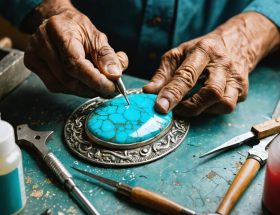Obsidian, nature’s volcanic glass, captivates with its rich spectrum of colors ranging from classic midnight black to mesmerizing rainbow sheens. This remarkable stone, formed when molten lava rapidly cools, exhibits distinctive color variations that have made it a sought-after material in both ancient artifacts and contemporary design. While pure obsidian presents as deep black due to its amorphous structure, trace elements and crystallization patterns create stunning variants including mahogany brown, snowflake white, and the iridescent rainbow obsidian with its dancing bands of gold, silver, and blue.
For architects and designers, obsidian’s color diversity offers unique opportunities to create dramatic focal points and sophisticated accents in both residential and commercial spaces. The stone’s natural luster and ability to reflect light differently based on its specific color variety makes it particularly valuable for statement pieces, wall features, and high-end surface applications where visual impact is paramount. Understanding these color variations is essential for professionals seeking to harness obsidian’s full aesthetic potential in modern design projects.
The Natural Color Spectrum of Obsidian
Classic Black Obsidian
Classic black obsidian stands as the most recognized and sought-after variety of this volcanic glass. Its deep, pure black coloration results from the rapid cooling of silica-rich lava, creating a natural glass with exceptional clarity and a mirror-like finish when polished. This variety exhibits remarkable uniformity in its color, making it particularly desirable for architectural applications and statement pieces.
The stone’s intense black hue comes from the presence of magnetite and other iron-rich minerals, resulting in a material that absorbs light rather than reflecting it. When properly cut and polished, classic black obsidian displays a vitreous luster and glass-like translucency along its edges. This distinctive appearance, combined with its durability and versatility, makes it an excellent choice for both decorative elements and functional surfaces in modern design schemes.

Mahogany and Red Obsidian
Mahogany and red obsidian variants occur when iron-rich minerals interact with silica during the volcanic glass formation process. These stunning variations display warm, reddish-brown to deep burgundy hues, often featuring subtle bands or streaks of darker coloration. The iron content typically ranges between 2-3%, creating the distinctive warm tones that make these specimens particularly sought-after for luxury interior applications. These varieties are commonly found in volcanic regions of Mexico and the western United States, with notable deposits in Oregon’s Glass Buttes. When polished, mahogany obsidian exhibits a rich, translucent quality that makes it especially appealing for decorative elements and statement pieces in modern architectural designs. The color intensity can vary significantly, from light amber tints to deep wine-colored specimens, offering designers a versatile palette for both contemporary and traditional spaces.
Rainbow and Gold Sheen Obsidian
Rainbow and gold sheen obsidian showcase nature’s remarkable ability to create stunning optical effects in stone. Rainbow obsidian displays bands of iridescent colors, including blue, purple, and gold, caused by microscopic inclusions of magnetite crystals that diffract light. This phenomenon, known as schiller, creates a shifting color display when the stone is viewed from different angles.
Gold sheen obsidian exhibits a distinct golden to bronze sheen across its surface, resulting from oriented inclusions of microscopic crystals. The effect is most pronounced when the stone is cut and polished into cabochons or curved surfaces. These varieties are particularly sought after for jewelry design and decorative objects, where their dramatic play of light can be maximized through strategic cutting and positioning.
Both varieties maintain obsidian’s characteristic glass-like qualities while offering unique optical properties that set them apart from standard black obsidian. Their distinctive appearance makes them popular choices for statement pieces in both modern and traditional design applications.

What Causes Obsidian’s Color Variations
The mesmerizing color variations in obsidian are primarily the result of specific geological conditions during its formation and the presence of various mineral impurities. When volcanic lava cools rapidly, it creates this natural glass with natural patterns and textures that can range from pure black to rainbow-like iridescence.
The classic black color occurs when the obsidian forms with minimal impurities and trapped gases. Iron and magnesium are the primary elements responsible for this deep, dark appearance. However, when trace amounts of different minerals become incorporated during formation, they create stunning color variations.
For instance, mahogany obsidian gets its reddish-brown hue from high iron oxide content, while snowflake obsidian features white crystal patterns caused by mineral inclusions of cristobalite. The spectacular rainbow or iridescent obsidian occurs when microscopic mineral particles create thin layers within the stone, causing light to refract and create shimmering colors.
Gas bubbles trapped during rapid cooling can create gold sheen obsidian, where tiny bubbles of magnetite create a golden sparkle effect. Similarly, silver sheen obsidian contains microscopic bubbles that reflect light in a silvery manner. Green obsidian derives its color from trace amounts of reduced iron, while blue obsidian typically contains nanoparticles of magnetite that scatter light in a particular way.
The volcanic environment’s temperature, cooling rate, and mineral composition all play crucial roles in determining the final color and pattern of obsidian. These factors, combined with varying levels of oxidation and the presence of different trace elements, create the diverse palette of obsidian varieties we see today. Understanding these color variations helps designers and architects choose the perfect obsidian variety for their specific applications while appreciating the complex natural processes that created these stunning stones.
Using Colored Obsidian in Design
Interior Applications
Obsidian’s dramatic appearance makes it an exceptional choice for interior applications, offering both sophistication and visual impact. In contemporary spaces, large obsidian slabs create striking accent walls that serve as natural focal points, particularly in living rooms and entryways. The stone’s reflective qualities enhance lighting and create depth, making it especially effective in smaller spaces.
For kitchen and bathroom applications, obsidian countertops provide a unique alternative to traditional materials. The stone’s naturally smooth surface and varied color patterns work particularly well in modern minimalist designs. When used in backsplashes, obsidian’s glossy finish adds dimension while protecting walls from moisture and stains.
Designers often incorporate obsidian in smaller decorative elements, such as fireplace surrounds, table tops, or inlay work. These applications allow the stone’s natural beauty to shine without overwhelming the space. In commercial settings, obsidian makes an impressive statement in reception areas and executive spaces, where its luxurious appearance conveys sophistication and permanence.
When planning obsidian installations, consider lighting carefully. Strategic placement of both natural and artificial light sources can enhance the stone’s reflective properties and highlight its color variations. For optimal results, combine obsidian with contrasting materials like light-colored woods or metals to create balanced, visually appealing spaces.
Remember that while obsidian is durable, it requires proper sealing and maintenance in high-traffic areas to preserve its appearance and functionality.

Exterior Applications
When using obsidian in exterior applications, careful consideration must be given to both climate conditions and installation methods. While obsidian is naturally durable, its glass-like properties require specific handling for outdoor use. In regions with extreme temperature fluctuations, smaller panels or tiles are recommended to minimize the risk of thermal stress.
For exterior wall cladding, a properly engineered anchoring system is essential. Mechanical fastening methods should be used instead of adhesives alone, particularly in areas with high humidity or frequent precipitation. The dark colors of obsidian can absorb significant heat, so adequate expansion joints should be incorporated into the design to accommodate thermal movement.
Obsidian performs exceptionally well in decorative features such as water features, garden sculptures, and accent walls. However, when used in horizontal surfaces like pathways or patios, a textured or honed finish is crucial for slip resistance. The stone should be sealed with a high-quality exterior stone sealer to protect against weathering and maintain its lustrous appearance.
Regular maintenance is key to preserving obsidian’s exterior applications. Annual inspections should check for any loose panels or deteriorating sealant. Clean the stone surfaces periodically with pH-neutral cleaners to prevent mineral buildup and maintain their dramatic appearance. In freeze-thaw climates, ensure proper drainage systems are in place to prevent water accumulation that could potentially damage the stone.
Maintaining Obsidian’s Natural Colors
Preserving obsidian’s striking natural colors requires proper care and maintenance. While obsidian is generally durable, how environmental factors affect stone appearance can impact its lustrous finish over time. To maintain its original beauty, keep obsidian surfaces away from direct sunlight, which can cause fading in some varieties, particularly the iridescent rainbow obsidian.
Clean obsidian surfaces regularly using a soft, lint-free cloth and pH-neutral stone cleaner. Avoid acidic cleaning products, as these can etch the surface and dull the stone’s natural sheen. For daily maintenance, warm water and a mild soap solution are sufficient. Always dry the surface thoroughly after cleaning to prevent water spots.
Seal your obsidian surfaces annually with a high-quality natural stone sealer to protect against staining and maintain color intensity. This is particularly important for obsidian used in high-traffic areas or exposed to moisture. Before applying sealer, ensure the surface is completely clean and dry.
Temperature fluctuations can affect obsidian’s appearance, so maintain consistent indoor temperatures when possible. In outdoor applications, consider using protective coatings specifically designed for natural stone exposed to weather elements.
Handle obsidian pieces with care, as sharp impacts can cause chips or cracks that may affect the stone’s color presentation. Use protective pads under decorative items, and avoid dragging objects across obsidian surfaces. For large installations, professional maintenance every few years can help preserve the stone’s natural beauty and extend its lifespan.
Obsidian’s diverse color palette, ranging from classic black to mahogany, green, and rainbow variations, makes it a versatile choice for modern design applications. These natural hues, formed through various geological processes, offer unique opportunities for creating striking visual impacts in both architectural and decorative contexts. Whether used in statement walls, countertops, or artistic installations, each color variant brings its own character while maintaining obsidian’s distinctive glass-like luster. The stone’s color stability and durability ensure that these aesthetic qualities endure over time, making it a reliable choice for long-term design investments. Understanding obsidian’s color variations helps designers and homeowners make informed decisions about incorporating this remarkable volcanic glass into their projects, creating spaces that balance natural beauty with contemporary design sensibilities.










